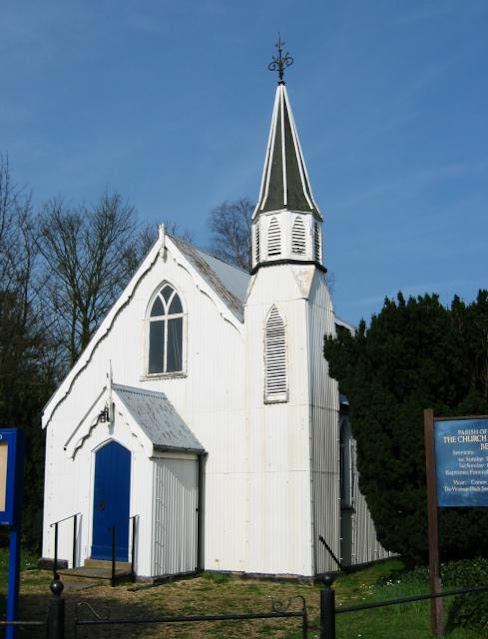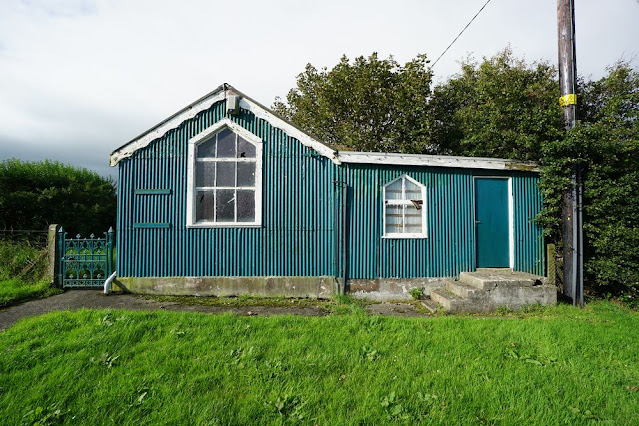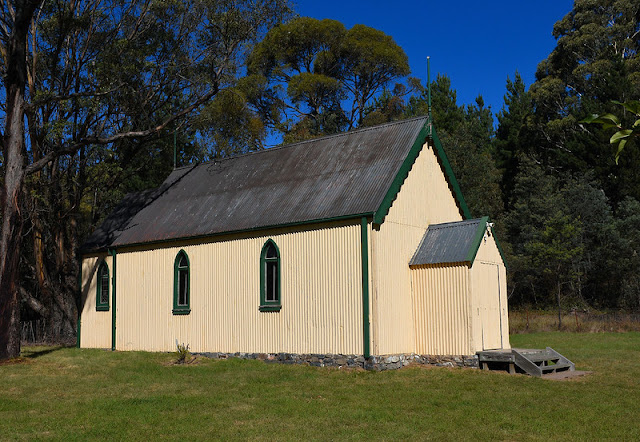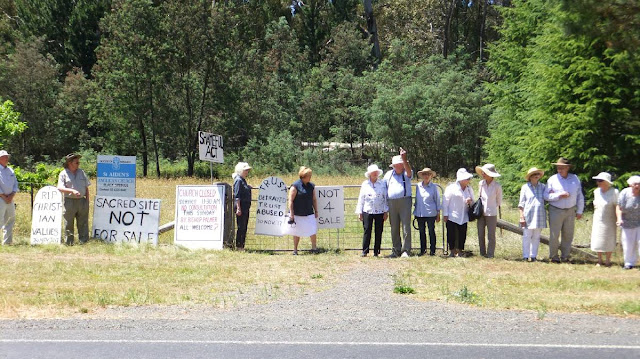--------o😊o--------
I mentioned in a previous post that I had, in the space of 2 days, received three connected items:
- I was thinking about a poem called Hay, Hell and Booligal;
- I received an email, as a subscriber to the website Amusing Planet, about a wholly cast iron church in Istanbul;
- Graham E sent me an email about “tin tabernacles” in Australia, the term for iron churches, with the first pic being of the Anglican Church in Booligal.
Okay, so that’s not much of a coincidence. It’s not like I had been thinking of a one-eyed dwarf with red hair with a parrot on his shoulder and then seeing one walking down the street but it still struck me as a coincidence.
So here’s the second part of my (fingers make air quotes sign) coincidental experience . . .
--------o😊o--------
Email from Graham E:
Hi Mr O,Came across a reference to “tin tabernacles” and their appearance in Australia, which led to these interesting items.....A tin tabernacle, also known as an iron church, is a type of prefabricated ecclesiastical building made from corrugated galvanised iron. They were developed in the mid-19th in the United Kingdom.Many ‘tin tabernacles’ appeared in Australia and New Zealand becoming part of the cultural identity. The Victorians used them for internal colonisation, 19 such churches were erected in Melbourne alone by 1851.
Graham also provided the following pics:
Anglican Church at Booligal, NSW
St Barnabas' Anglican church at Oxley, New South Wales
Wesleyan Church, Darwin, Northern Territory.
Originally built in Adelaide, South Australia, it was shipped to Darwin in 1897. It was restored and moved to the George Brown Darwin Botanic Gardens in 2001, where it is used as a cafe.
The Corrugated Iron Church was built as part of the 'Goddess of 1967' movie film set in Lightning Ridge New South Wales Australia
Thanks Graham.
Some points made by the Wikipedia article:
- Corrugated iron was first used for roofing in London in 1829 by civil engineer Henry Robinson Palmer, and the patent was later sold to Richard Walker who advertised "portable buildings for export" in 1832.
- The technology for producing the corrugated sheets improved, and to prevent corrosion, the sheets were galvanised with a coating of zinc.
- After 1850, many types of prefabricated buildings were produced, including churches, chapels and mission halls.
- The Industrial Revolution was a time of great population expansion and movement in Europe. Towns and cities expanded as the workforce moved into the new industrial areas resulting in the building of more than 4,000 churches during the mid 19th century and a demand for even more buildings.
- William Morris, founder of the Arts and Crafts Movement, wrote a pamphlet in 1890 decrying the construction of corrugated iron buildings "that were spreading like a pestilence over the country."
- Several tin tabernacles survive as places of worship; some have listed building status and some have been converted to other uses. Some redundant chapels have been moved to museums for preservation.
Some Brit tin tabernacles:
Church of England mission church at Alhampton, Somerset, seen from the north. A "tin tabernacle" building completed in 1892.
Village hall at Bartley, Hampshire, seen from the southeast. It was built as a Church of England mission church.
The Church of The Ascension near Bedmond, England. A perfect example of the tin tabernacle design, and still in fairly good condition.
St Peter's Church, Wellhouse Road, Beech, East Hampshire District, Hampshire, England. An Anglican tin tabernacle dating from 1902. Along with the Church of the Holy Rood in Holybourne and All Saints Church and St Lawrence's Church in Alton, it is one of four churches in the Parish of the Resurrection, Alton.
Former Christ Church (Blackgang Mission), Blythe Shute, Blackgang, Chale, Isle of Wight, England. Built in 1895 to replace an earlier mission hall registered in 1882, this was variously described as Baptist, Independent and undenominational in character. It is now used as a holiday cottage.
Church in the Woods, Bramdean Common, near Bramdean, City of Winchester District, Hampshire, England. A tin tabernacle in the middle of a wood by Bramdean Common, built in 1883 at the expense of Rev. A.C. Bishop of Bramdeaen for "the commoners, charcoal burners and itinerant gypsies who seasonally occupied Bramdean Common". Services are held twice a month in the summer.
Tin tabernacle at Sandling, Kent.
. . . and one from Ireland:
Tin Tabernacle in Ballywillin. Ireland
--------o😊o--------
Talking of tin churches, here’s a feelgood story for the day, dating from 2018 . . .
Imagine a little tin church is the woods that the church decides to close and sell off, along with 11 other churches, to raise about $2 million to provide compensation to victims of institutional child abuse in the region.
That’s what happened to the former Anglican church of St Aidan's at Black Springs, near Oberon NSW in 2018. Saint Aidan's was listed for sale online at $130,000 for the 127-year-old heritage-listed small tin church and the three acres of native forest.
The locals were not happy:
Then their saviour came along and made the church rise from the dead. Former park ranger Andrew Wilson, when he saw that St Aidan's was for sale online, offered the local diocese full price of $130,000 and bought it. He then mowed the lawn that surrounds the little tin church and handed the keys back to the congregation, which had been locked out by the diocese. According to Andrew Wilson: "There are no conditions. Period. I trust you enough to give you a key, and take it wherever the spirit leads you."
He has no plans to get involved or attend the church, other than do some caretaking and gardening and explore the bush behind. "I have been driving past for more than 50 years. I always stopped outside that particular church, it had an amazing sense of calm and peacefulness.:
Andrew Wilson
Some have suggested that there was more to the intended sale than raising capital.
In a letter at the time of closing and lockout of parishioners, Bishop Ian wrote explaining the property would be sold but raised other issues, including the congregation's refusal to "receive Holy Communion" and the fact that they had spoke badly of him and others. "It is clear that they have broken fellowship," Bishop Ian wrote. He told Fairfax Media that the rule requiring members of the congregation to take communion three times a year to be eligible to counted as parish members dated back more than 400 years to the Book of Common Prayer.
Now, however, the parishioners are again happy, God’s in His Heaven and all’s well with the good folk of Black Springs.
Source:
--------o😊o--------
Istanbul’s cast iron church:
The Bulgarian St. Stephen Church with its richly ornamented façade on the shores of the Golden Horn in Istanbul, Turkey, is made of iron. It was cast in Vienna, floated down the Danube and across the Black Sea on barges, and bolted together in Istanbul in 1871. It is possibly the largest prefabricated cast iron structure in the world.
Some pics:
The original wooden church which was replaced by the cast iron church when the wooden church burnt down
An early 20th-century postcard depicting the Bulgarian St Stephen Church






























No comments:
Post a Comment
Note: Only a member of this blog may post a comment.